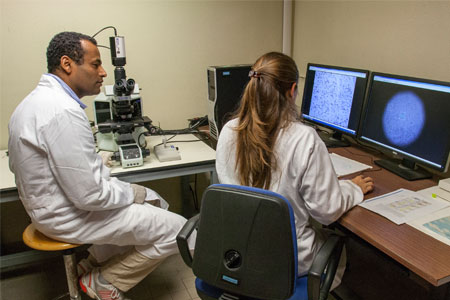- Authors:
-
van Eekelen, Leander; Spronck, Joey; Looijen-Salamon, Monika; Vos, Shoko; Munari, Enrico; Girolami, Ilaria; Eccher, Albino; Acs, Balazs; Boyaci, Ceren; de Souza, Gabriel Silva; Demirel-Andishmand, Muradije; Meesters, Luca Dulce; Zegers, Daan; van der Woude, Lieke; Theelen, Willemijn; van den Heuvel, Michel; Grünberg, Katrien; van Ginneken, Bram; van der Laak, Jeroen; Ciompi, Francesco
- Title:
-
Comparing deep learning and pathologist quantification of cell-level PD-L1 expression in non-small cell lung cancer whole-slide images
- Year:
-
2024
- Type of item:
-
Articolo in Rivista
- Tipologia ANVUR:
- Articolo su rivista
- Language:
-
Inglese
- Format:
-
Elettronico
- Referee:
-
No
- Name of journal:
- SCIENTIFIC REPORTS
- ISSN of journal:
- 2045-2322
- N° Volume:
-
14
- Number or Folder:
-
1
- Page numbers:
-
1-10
- Keyword:
-
B7-H1 Antigen; Biomarkers, Tumor; Carcinoma, Non-Small-Cell Lung; Deep Learning; Humans; Immunohistochemistry; Lung Neoplasms; Pathologists
- Short description of contents:
- : Programmed death-ligand 1 (PD-L1) expression is currently used in the clinic to assess eligibility for immune-checkpoint inhibitors via the tumor proportion score (TPS), but its efficacy is limited by high interobserver variability. Multiple papers have presented systems for the automatic quantification of TPS, but none report on the task of determining cell-level PD-L1 expression and often reserve their evaluation to a single PD-L1 monoclonal antibody or clinical center. In this paper, we report on a deep learning algorithm for detecting PD-L1 negative and positive tumor cells at a cellular level and evaluate it on a cell-level reference standard established by six readers on a multi-centric, multi PD-L1 assay dataset. This reference standard also provides for the first time a benchmark for computer vision algorithms. In addition, in line with other papers, we also evaluate our algorithm at slide-level by measuring the agreement between the algorithm and six pathologists on TPS quantification. We find a moderately low interobserver agreement at cell-level level (mean reader-reader F1 score = 0.68) which our algorithm sits slightly under (mean reader-AI F1 score = 0.55), especially for cases from the clinical center not included in the training set. Despite this, we find good AI-pathologist agreement on quantifying TPS compared to the interobserver agreement (mean reader-reader Cohen's kappa = 0.54, 95% CI 0.26-0.81, mean reader-AI kappa = 0.49, 95% CI 0.27-0.72). In conclusion, our deep learning algorithm demonstrates promise in detecting PD-L1 expression at a cellular level and exhibits favorable agreement with pathologists in quantifying the tumor proportion score (TPS). We publicly release our models for use via the Grand-Challenge platform.
- Product ID:
-
138868
- Handle IRIS:
-
11562/1123713
- Last Modified:
-
June 6, 2024
- Bibliographic citation:
-
van Eekelen, Leander; Spronck, Joey; Looijen-Salamon, Monika; Vos, Shoko; Munari, Enrico; Girolami, Ilaria; Eccher, Albino; Acs, Balazs; Boyaci, Ceren; de Souza, Gabriel Silva; Demirel-Andishmand, Muradije; Meesters, Luca Dulce; Zegers, Daan; van der Woude, Lieke; Theelen, Willemijn; van den Heuvel, Michel; Grünberg, Katrien; van Ginneken, Bram; van der Laak, Jeroen; Ciompi, Francesco,
Comparing deep learning and pathologist quantification of cell-level PD-L1 expression in non-small cell lung cancer whole-slide images
«SCIENTIFIC REPORTS»
, vol.
14
, n.
1
,
2024
,
pp. 1-10
Consulta la scheda completa presente nel
repository istituzionale della Ricerca di Ateneo 








